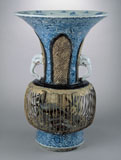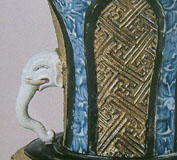- Museum Accession No.: EA1992.114
- Catalogue No.: 152
- Object type: Vase
- Kiln/Location: Blue-and-white, Arita
- Period/Date: early 18th century
- Dimensions: H. 57.0 cm; With wood, metal, papier-mache, textile and Lacquer
- Provenance: Story Fund
- Description: Birdcage vase. Trumpet-shaped. Underglaze blue decoration of flowers and leaves, with dragons in interior of the lip. Gold-lacquered lappets. Two porcelain elephant-headed handles above a lacquered wood, wire, papier-mache and gilded cage containing two enamelled porcelain pheasants with wire legs, and porcelain flowers with lacquered textile and wire stems, on lacquered wood rockwork. Ink mark, very faint, N.18, on base.
There is considerable damage and loss to this piece: few of the deeply-modelled porcelain flowers are present, and some of the rockwork has been lost and clumsily repaired, though both birds are present. Freely-modelled flowers and birds are extremely rare in Japanese porcelain. There are some twelve examples present in the Porzellansammlung, Dresden today - one is illustrated in Porcelain for Palaces, 1990, fig. 17. In 1735, there must have been at least fourteen, as spaces for fourteen examples are clearly indicated on the drawing by Zacharias Longelune, now in the Staatsarchiv; for a project for a wall of the Japanese Palace, see Reichel, 1980, pls. 120, 121; and Porcelain for Palaces, 1990, fig, 16. Other examples are at the Chateau de Pau (three, formerly in the collection of the Duc de Conde, see Nelson and Impey, 1994); two in the Rijksmuseum, Amsterdam (Jorg, 2003, no. 344); and in the Peabody-Essex Museum, Salem. See also no. 153. Two were sold from Dresden in 1920 (Rudolph Lepkes Kunst-Auctions-Haus, Berlin, 14.10.1920, lots 1488, 1489). Avariation of this
type is in the Kurita Museum, Ashikaga. Meissen copies, or, rather pastiches, exist both in blue-and-white and in enamel colours; the rockwork is modelled onto the body as are the two rings to hold the wires; the birds were fired separately and would have had legs added, fitted into holes left for the purpose. Such copies were first made in 1727; Pietsch, 1996, quotes the order
of that date from the Factory Inspector, David Reinhardt (Betriebsarchiv eissen, AA 1 Ab 2, fol. 89R and 90). For an enamelled Meissen pastiche, see Reichel, 1980, pl. 94. Le Duc, 1996, suggests that the drawing by Fraisse, 1735, no. 45, contains a vase that derives from this shape.
- Exhibited:
- Similar Example:
- Illustrated: Nelson and Impey, 1994, fig. 2
|
Main View
|




